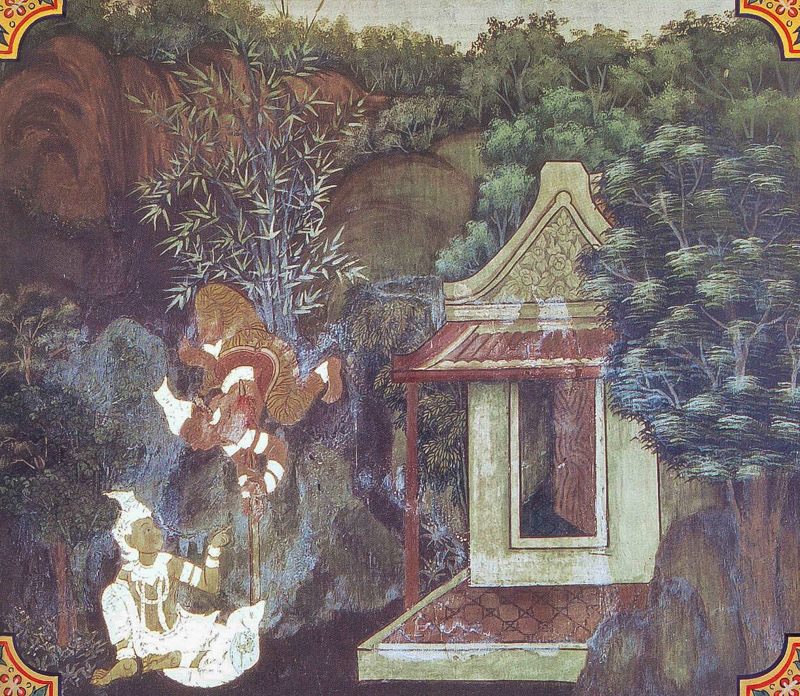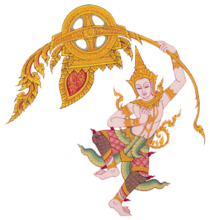
The Bodhisatta was once an ascetic. Before this, he was a wealthy brahmin who, along with an equally wealthy friend, gave away everything he owned and forsook the world. The pair lived together in the Himalayas, eating wild fruits and roots, but never managed to attain full insight. After fifty years in the wilderness, they went down to a town to get salt and seasoning, and stayed in a cemetery for a while. Then the Bodhisatta went to stay at a friend’s house in another town, while his companion remained behind.
One day a thief was caught in the act, and the homeowners and guards gave chase. The thief fled through the sewer into the cemetery, where he dropped his haul in front of the ascetic’s hut. When the homeowners saw it lying there, they assumed the ascetic was the thief. They beat him and hauled him off to the king who, without investigating the matter at all, ordered the ascetic executed by impalement.
The king’s men first tried to impale him with a stake made of acacia wood and then stakes made of neem wood and iron, but none of these would pierce the ascetic’s skin. The ascetic was as surprised about this as the executioners, so he scanned his memories looking for the cause and saw that as a child in a previous life he had pierced a fly with a splinter of ebony. Knowing he could not escape the karma of this past sin, he told the men they must use a stake made of ebony, which they did.
At this time, the Bodhisatta thought about his fellow ascetic and went back to visit. Finding him hanging along the roadside, the Bodhisatta asked what he had done. He answered that he had done nothing wrong, but he did not feel any hatred toward his accusers or the king. The Bodhisatta was pleased and said the shadow of such a virtuous person was delightful, so he sat down next to the stake and remained there into the night, not minding the drops of blood that fell upon his skin.
When the king heard about the Bodhisatta’s action, he realized he had acted rashly. The king rushed to the scene, and the Bodhisatta rebuked him for not examining both sides before declaring guilt. The king did so then, and he found the ascetic innocent and ordered the stake removed. But it would not come out—this was due to the same past action with the fly, after which he stuck a small piece of diamond into a duct so it would not die until the natural end of its life. The apologetic king had his men saw off both ends of the stake, keeping the part inside his body intact.
The Bodhisatta took care of his fellow ascetic until his wound healed, and then he returned to his friend’s house. As the family listened to the Bodhisatta tell them about his friend’s ordeal, their young son was bitten by a venomous snake and fell unconscious. The parents asked the Bodhisatta to heal him, but he said he knew no magical chants. So they asked him to speak an act of truth (a solemn declaration of one’s supreme virtue followed by a request for some miraculous result), and as he did, some of the venom fell out of the boy’s chest, reviving him. Because he needed to speak the whole, complete truth, the Bodhisatta admitted in front of the others that he did not enjoy the ascetic life. Then the Bodhisatta told the father he must also speak truthfully, and he proclaimed his generosity, but admitted that selfishness was his true nature and he gave reluctantly. More venom came out of the boy’s back and he sat up, but remained weak and could not stand. The mother followed with an admission that she did not love her husband, and all the rest of the venom drained out. The boy got up and began to play normally.
They were all taken aback by each other’s admissions and explained themselves. The Bodhisatta did not give up the ascetic life after starting it because he did not want to be judged a fool. The husband was only generous because his father and grandfather had been so. And the wife was just a young girl when her family married her off, and she did not want to disappoint them. But after discussing these things, they found new perspectives and changed from disappointment with their lives to happiness.
In the Lifetime of the Buddha
A man of noble birth gave up his easy life to become a disciple of the Buddha and was completely dedicated to dharma. One day during an alms round he met a beautiful woman and fell in love at first sight. Overcome by passion, he became so depressed that he stopped cutting his hair and nails and cleaning his robes, became thin and weak with yellow skin and veins sticking out of his body, and no longer took joy in his life of solitude.
The Buddha criticized the disciple’s behavior and told this story as an example of how he himself had stopped caring about the holy life in the past but didn’t stop living with proper conduct. Hearing this, the disciple got back on the right path.
The Bodhisatta’s fellow ascetic and good friend were earlier births of Sariputta and Ananda, two of the Buddha’s top disciples. The friend’s wife and son were earlier births of the Buddha’s wife and son.
